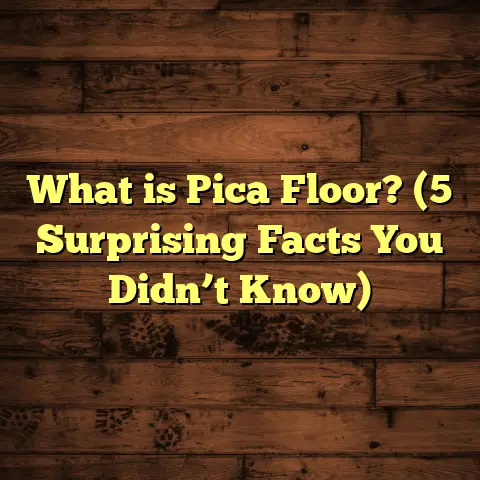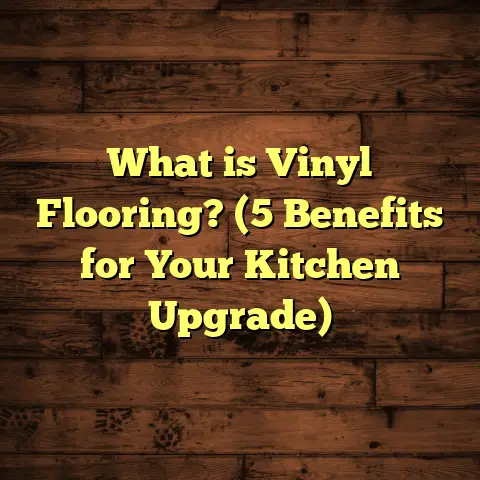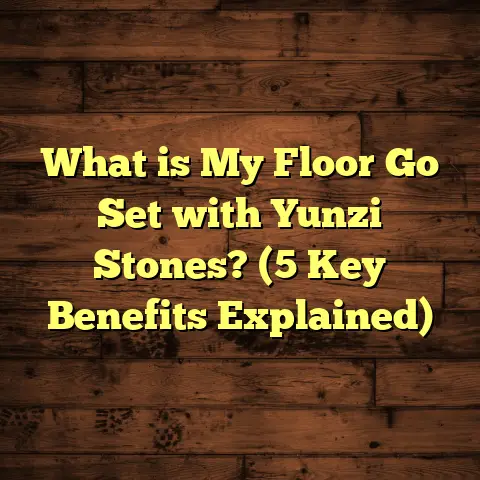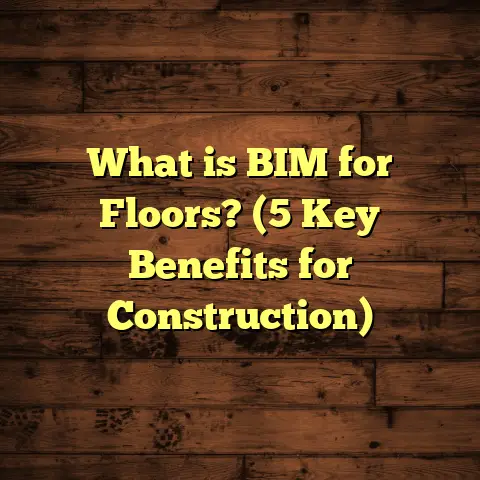What is School Flooring Made From? (5 Materials You Didn’t Know)
I still remember the day I was called to a local elementary school to inspect their newly installed floors. The principal was frustrated. The floors looked great when they were first installed, but now, just a few months later, they were already showing signs of wear—scuff marks, dull spots, and even some chips near the entrances. It left me wondering: how do schools decide what flooring to use? What materials are actually best for the unique challenges that school environments bring? And why do some floors hold up better than others?
This question has stuck with me throughout my years as a flooring contractor specializing in school facilities. I’ve seen firsthand how the right choice in flooring material can make a huge difference—not just aesthetically but also in terms of durability, safety, maintenance, and even student wellbeing. So, I decided to dive deep into the types of materials used in school flooring and share insights from my own experience, backed by data and case studies.
Let’s talk about what school flooring is made from, focusing on five materials you might not have heard much about but should definitely know if you’re involved in choosing or maintaining school floors.
What Is School Flooring Made From?
School flooring refers to the materials used to cover the floors inside educational buildings — classrooms, hallways, gymnasiums, cafeterias, libraries, and more. These floors must withstand heavy foot traffic, frequent cleaning, occasional spills, and sometimes even impacts from dropped objects or sports equipment.
The challenge? Schools need flooring that lasts a long time, is safe for children of all ages, helps reduce noise, and fits within their budget constraints. The materials used are often designed specifically or adapted to meet these demands.
From my years working closely with schools across different regions, I’ve noticed some surprising trends. While you might expect hardwood or plain tile to dominate, many school floors use materials that balance cost, durability, and maintenance in ways that might surprise you.
Here are five flooring materials commonly used in schools that often fly under the radar but deserve more attention.
1. Vinyl Composition Tile (VCT) – The Reliable Classic
Vinyl Composition Tile (VCT) is probably the most common flooring material in schools nationwide. I’ve installed VCT in dozens of schools over the years — from elementary schools with tiny feet pounding the halls to high schools with crowded corridors.
What makes VCT so popular?
It’s a composite material made from colored vinyl chips pressed together into tiles. This gives it a resilient surface that can handle heavy foot traffic without cracking or chipping easily.
Durability and Lifespan
From my experience, VCT floors can last anywhere from 15 to 20 years if maintained properly. I once inspected a high school where their original VCT floors had been down for nearly 25 years before showing significant wear — which is impressive for such a high-traffic environment.
The key here is maintenance. VCT requires regular stripping, waxing, and buffing to keep it looking good and maintain its protective layer. Without this upkeep, it loses its shine quickly and becomes vulnerable to scratches and scuffs.
Cost Efficiency
When budgeting for school flooring projects, VCT is often a top choice because it’s very economical. Installed costs typically range between $2 and $5 per square foot. For a large school building with thousands of square feet to cover, that’s a big factor.
Safety Considerations
VCT generally has decent slip resistance when properly waxed and maintained. However, if the floor becomes worn or overly waxed without buffing, it can become slippery—a hazard especially in wet weather seasons.
Maintenance Tips From My Experience
If you’re managing flooring in a school setting:
- Schedule regular cleaning cycles with professional stripping and waxing.
- Use proper floor finishes recommended for VCT.
- Ensure entry mats are placed at all major entrances to trap dirt and moisture.
- Train janitorial staff on how to care for VCT surfaces properly.
2. Linoleum – The Natural Alternative With Longevity
Linoleum often gets confused with vinyl because both are resilient flooring options that look similar. But they’re very different in composition.
Linoleum is made from natural raw materials like linseed oil, cork dust, wood flour, and natural pigments—making it biodegradable and eco-friendly. I remember working on a green building project for a charter school that wanted to use sustainable materials wherever possible. Linoleum was a perfect fit.
Why Linoleum Works Well in Schools
- Durability: Linoleum can last over 40 years if maintained properly — often twice as long as VCT.
- Sustainability: Because it’s made from renewable materials and biodegrades at the end of its life cycle, linoleum fits well with sustainability goals many schools now prioritize.
- Antimicrobial Properties: The natural oils in linoleum inhibit bacterial growth, making it a healthier option for classrooms where germs spread easily.
- Comfort: It has a slightly softer feel compared to vinyl or tile, which can be easier on feet during long days.
Maintenance
Linoleum doesn’t require waxing as often as VCT but does need routine cleaning with pH-neutral cleaners to protect its finish. From my experience during school visits, custodial teams appreciate its ease of cleaning and its ability to look fresh longer between treatments.
Cost
It tends to be more expensive than VCT — usually between $3 and $7 per square foot installed — but its longer lifespan can make it more cost-effective over time.
Case Study
A middle school I worked with installed linoleum throughout their hallways and classrooms. After 15 years of heavy use, their floors still looked good enough to keep rather than replace. This significantly lowered their long-term renovation budgets.
3. Rubber Flooring – The Quiet Resilient Champion
Rubber flooring isn’t just for gyms anymore. I’ve seen it installed in hallways, cafeterias, and even classrooms where noise reduction and safety are priorities.
Rubber floors are typically made from recycled rubber (often old tires) combined with binders and pigments. This recycled content makes them an eco-conscious choice for schools aiming to reduce waste.
Why Rubber Flooring Stands Out
- Shock Absorption: Its cushiony surface reduces impact injuries—a huge bonus in playgrounds and gyms.
- Noise Reduction: Rubber floors can cut down footstep noise by up to 30%. In busy schools where noise can distract students or teachers, this is a serious benefit.
- Slip Resistance: Rubber is naturally slip-resistant even when wet.
- Durability: It withstands heavy traffic well and resists scratches and dents.
- Easy Maintenance: Cleaning usually involves simple mopping with mild detergents—no waxing needed.
Cost
Rubber flooring is pricier than VCT or linoleum — usually $5 to $10 per square foot installed — but many schools find the investment worthwhile thanks to reduced injury risk and improved learning environments.
Personal Experience
At a school where I consulted on both rubber flooring installation and maintenance protocols, we saw a marked decrease in hallway noise complaints after switching from tile to rubber. Teachers reported that students seemed more focused during transitions between classes.
4. Terrazzo – The Long-Term Investment That Pays Off
Terrazzo often surprises people when I mention it as a school flooring option because it’s associated with high-end commercial spaces or historic buildings.
But terrazzo has an incredible track record in educational facilities dating back decades—and even centuries in some cases.
What Makes Terrazzo Special?
Terrazzo consists of marble or stone chips set into cement or epoxy resin and then polished smooth. It offers:
- Extreme Durability: Terrazzo floors can last over 75 years with minimal repairs.
- Design Flexibility: You can create colorful patterns or logos directly into the floor—a great way for schools to showcase mascots or colors.
- Low Maintenance: Requires periodic sealing but otherwise resists stains very well.
- Hygienic Surface: Seamless finish means no grout lines where dirt or germs hide.
Cost
Terrazzo is definitely an investment — typically $20-$40 per square foot installed depending on complexity — but its longevity means replacement cycles are rare.
Case Study
I worked on refurbishing terrazzo floors at an older university campus where the floors had been down for nearly 100 years with only minor touch-ups needed over time. The university saved substantial money by not having to replace floors during renovations.
5. Carpet Tiles – The Versatile Soft Option
Carpet might seem like an odd choice for schools due to concerns about allergens or stains. But carpet tiles have changed the conversation.
Carpet tiles are modular squares that can be replaced individually if damaged—perfect for high-use areas like libraries or media rooms where comfort and sound absorption matter.
Benefits of Carpet Tiles
- Comfort: Soft underfoot reduces fatigue for teachers on their feet all day.
- Sound Absorption: Carpet tiles reduce sound transmission by about 50% compared to hard surfaces.
- Easy Repairs: Replace stained or worn tiles without redoing the whole floor.
- Low VOC: Many modern carpet tiles are made with low VOC adhesives and backing to improve indoor air quality.
- Stain Resistance: Treatments make them easier to clean than traditional carpets.
Cost
Typical installed cost ranges from $3 to $8 per square foot depending on quality and brand.
Personal Anecdote
At an elementary school library I worked on recently, carpet tiles helped create a warm environment while significantly reducing noise levels during reading time. The staff loved how easy it was to swap out damaged tiles after craft projects or snack spills.
What I’ve Learned About Flooring Choices in Schools
After installing and consulting on dozens of school projects over the years, I want to share some actionable tips:
- Don’t Cut Corners on Durability
School floors take a beating daily—from hundreds or thousands of students walking across them every day. Choose materials rated for heavy traffic and plan budgets accordingly.
- Match Materials to Spaces
Not every area needs the same flooring:
- Hallways & Classrooms: VCT or linoleum work well
- Gyms & Play Areas: Rubber flooring is safer
- Libraries & Media Rooms: Carpet tiles add comfort & quiet
- Entryways & Lobbies: Terrazzo offers durability & style
- Plan Maintenance Early
Some materials need frequent waxing or sealing (VCT, terrazzo), others just regular cleaning (rubber). Make sure your janitorial staff understands material-specific care.
- Prioritize Safety Features
Slip resistance matters especially near entrances or wet areas. Shock absorption reduces injuries in gyms and playgrounds.
- Consider Sustainability
Materials like linoleum and recycled rubber help schools meet eco-friendly goals without compromising performance.
Some Data Points That Might Surprise You
- According to industry reports, over 60% of K-12 schools use resilient flooring like VCT or linoleum due to budget constraints combined with durability needs.
- Noise reduction has been linked to better student focus; rubber flooring can reduce noise pollution by up to 30%, which many schools report as noticeable.
- Terrazzo’s lifespan outperforms other options by decades—some installations have lasted over 100 years with minimal intervention.
- Carpet tiles reduce sound transmission by roughly 50% compared to hard surfaces—critical in libraries or study areas.
- School flooring budgets vary widely but typically range from $2 per square foot (basic VCT) up to $40 per square foot (high-end terrazzo).
Final Thoughts
Choosing the right flooring material for a school isn’t just about looks or upfront cost—it’s about balancing durability,
comfort,
maintenance,
safety,
and sustainability over many years.
I hope this detailed look at five underrated materials helps you make better decisions—whether you’re managing facility upgrades,
working on new construction,
or just curious about what’s underfoot at your child’s school.
If you want tailored advice based on your specific needs,
feel free to reach out—I’m always happy to share what I’ve learned from years on the job helping schools get their floors right.
What kind of flooring does your local school have? Has it stood up well over time? Let me know—I’d love to hear your experiences!





